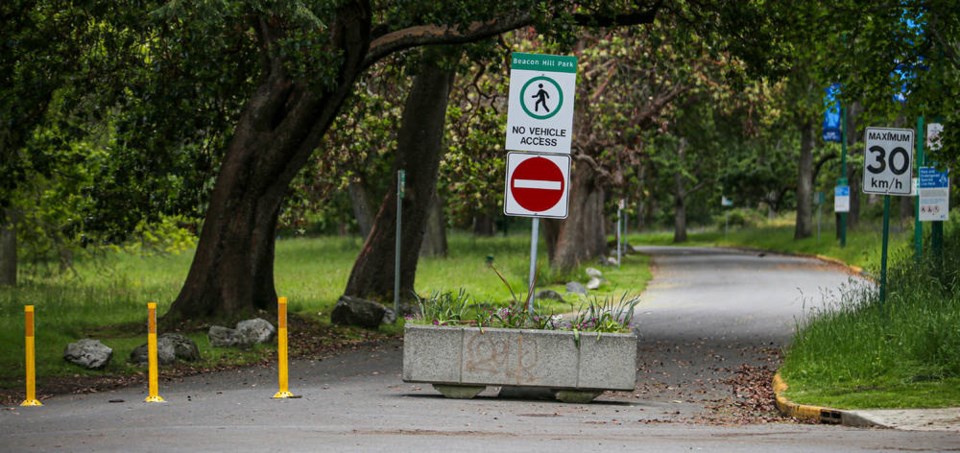Motor vehicles will remain banned on about half the roads in Beacon Hill Park.
Councillors debated Thursday expanding vehicle access after Coun. Stephen Andrew proposed reopening all roads in the park to cars. Andrew said council’s previous decision to implement a partial ban — made before Andrew joined council in a December byelection — shut seniors and those with disabilities out of Beacon Hill.
“We’ve seen the horrific effects of that on a number of people, but I think it’s time that we provide something, give something back to our citizens,” he said.
There are several parking lots within the park boundaries, including at the summit lookout and the petting zoo, but access to a lot near the playground has been cut off with the closure of some roads, and a cut-through route from Southgate Street to Dallas Road is no longer possible.
All roads were closed last May to give pedestrians more room for physical distancing, but council eased the ban in November after receiving feedback that was mostly critical of the closures.
The roads that remain closed are Arbutus Way, which provides an entrance to the park from Southgate Road, and Chestnut Row and Bridge Way, both of which connect to Arbutus Way. Roads open to motor vehicles include Circle Drive, cutting through the park from Douglas Street to Dallas Road, Heywood Way, Nursery Road and the road to the summit.
Some have said that those with limited mobility are no longer able to drive through the park or park within 100 metres of their favourite spots, while others say they feel safer with fewer vehicles in the park.
A partial reopening of roads was supported by councillors Charlayne Thornton-Joe and Marianne Alto.
Thornton-Joe said road closures prior to last spring have been beneficial to the park, but she was concerned about the impact of more recent closures.
“I think our main concern is accessibility and accessibility may be a person that uses a mobility device, but accessibility also means someone taking their elderly parent for a drive through Beacon Hill Park to bring back memories of when they were younger,” she said.
Coun. Geoff Young said many of the people who have written to council have requested a level of motor vehicle access that is difficult to satisfy without affecting the park.
Young pointed to the southwest corner of the park, home to the Terry Fox statue, as an example of the conflict between providing accessibility for those with mobility challenges and creating a usable space.
“Total accessibility and almost no use as parkland, because it’s surrounded by vehicle traffic,” he said.
He also said drivers underestimate the impact they have on more vulnerable road users.
“Some little kids are playing 50 feet from the road. [The drivers] see the kids, they’re driving carefully, they don’t see a danger, but I can tell you if you’re the parent of the little kid who’s playing 50 feet from the road and you see the cars driving through, you do feel a danger,” he said.
Other councillors said they felt council had already found a balance between accessibility for drivers and safety for other park users.
Coun. Ben Isitt said he did not support expanding access for vehicles, because many park users enjoy having space that’s not shared with cars, and there’s no area in the park that’s more than 200 metres from motor vehicle access. He also said previous councils have closed other roads in the park once available to cars, including a road over an old stone bridge near Goodacre Lake.
“I think there’s ample opportunities to visit the park by a motor vehicle, and I don’t support moves that would decrease the public’s enjoyment,” he said.
Vancouver also closed roads in Stanley Park to vehicles in response to COVID-19 to give cyclists space to ride through unrestricted, while the seawall was closed to cyclists to make space for pedestrians. Last September, the city reopened the right lane of most park roads to vehicles, and reopened the seawall to cyclists.



